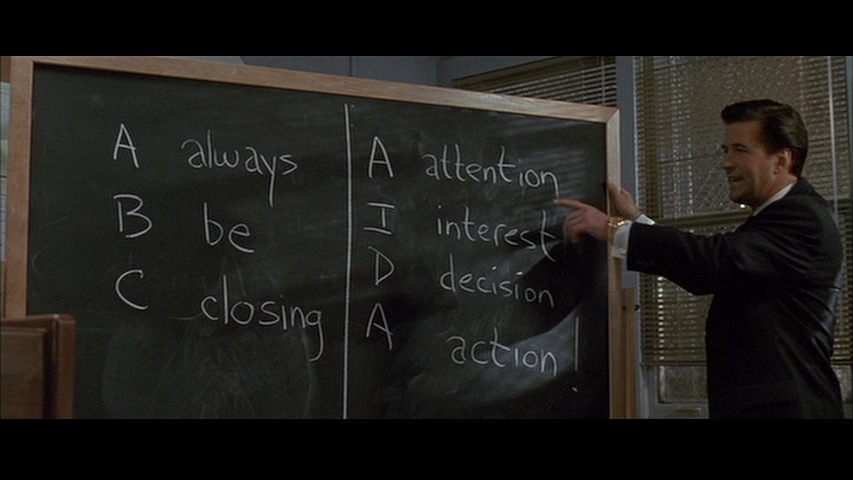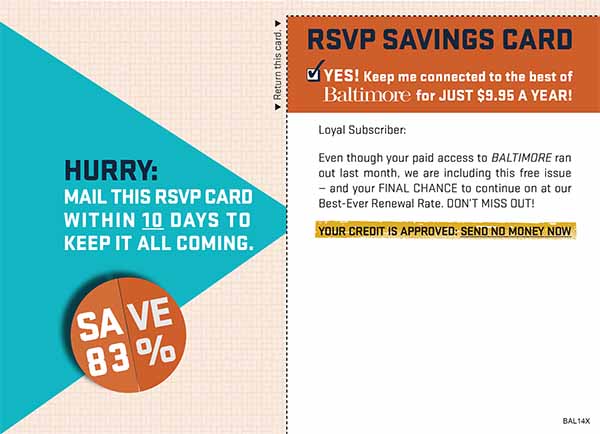Stick around ’til the end of the post to hear how this magazine onsert performed!
Do you know about AIDA? No, not the opera by Giuseppe Verdi — I’m talking about the process by which your customers engage with your direct response advertisement and make a purchase decision. AIDA is a critical framework for every audience development campaign. Alec Baldwin brought this particular marketing acronym to the attention of the public in his classic NSFW “motivational speech” in the film Glengarry Glen Ross.

As Mr. Baldwin so succinctly explains, AIDA stands for:
A – attention
I – interest
D – desire/decision
A – action
In direct response marketing, this order is extremely important. After all, you don’t walk up to a prospective date in the bar by handing them your phone number, right? You start with something witty that catches their attention, then you wow them with your brilliance (interest) until they come to the conclusion that they want to date you (desire), and only then do you create the opportunity for them to take the desired action. (In this case, a date with your fabulous self.)
Not too long ago, I was working on a polybagged onsert for Baltimore Magazine and realized that when you’re working on a piece with limited real estate, AIDA is more important than ever. Here’s the first page of the final product:
The onsert is a 4/4 loose sheet of paper (i.e. not tipped on) with the lapsed subscriber’s addressing imaged onto the reply card area so it also functioned as the addressing for the grace issue it was polybagged with. Behind this onsert we included a BRE to increase cash with order.
Now I’m going to break out the pieces.
1. Attention
Warnings are always a good way to capture somebody’s attention. We’re also cluing the recipient in to the fact that the issue they’re receiving is no longer part of their paid subscription, which is important because the point of sending a grace issue after the lapse of their subscription is to entice them to continue subscribing, not just continue to give away free issues with the consumer being none the wiser.
2. Interest
Now that you’ve got their attention, why should they care? Let the recipient know what’s in it for them. Perhaps these subscribers didn’t even realize their subscription had ended, so this is definitely of interest to them.
3. Desire
OK, you’ve piqued their interest. Now what is it you want them to want? To stay on your subscriber list of course. And of course they’re also going to want the best-ever rate, versus what other readers pay. In the desire stage, you’re presenting the offer. If they’re on board their next question is how do they fulfill this desire?
4. Action
Finally your recipient is ready to take action. Notice how the giant triangle on the left side points right to the tear-off reply card? In direct response, you have to be very clear about the action you want the consumer to take. “Mail this RSVP card within 10 days,” “Return this card,””Send no money now,” all work to clue the recipient in to what they’re supposed to do next to take advantage of the offer you’ve presented.
And there you have it! Longer direct mail pieces, either in print or digital, can expand on this over the course of several pages or components, but this is the framework upon which it’s all built.
So how did this onsert perform? Here’s the scoop straight from the client:
“Baltimore Magazine is getting a great 7-10% response on this cost-effective Onsert, which is smarter than simply sending the grace issue without an offer!” — Lori Birney, Director of Circulation Baltimore Magazine
That’s a pretty awesome response rate, and proves how this simple yet elegant framework can go to work to increase your publication’s circulation.
At AdSpace we take pride in creating direct response advertising that has a solid foundation in marketing so we think about stuff like this a lot. If you’d like to get our brains working on a solution to one of your marketing problems, write to us or call to say hi!







Recent Comments